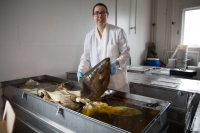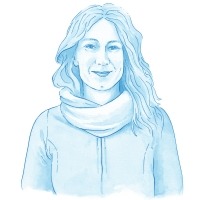
Claire Goodwin,
Curator of Atlantic Reference Centre Museum
Claire Goodwin is a Curator of the Atlantic Reference Centre (ARC), a museum of Atlantic Canadian marine life, in St. Andrews, New Brunswick. Her job involves looking after the thousands of specimens in the ARC’s museum collections. She studies sponges and goes SCUBA diving to find sponge species new to science.
Dive DeeperMarine Career Interview
What do you do?
I’m a Research Scientist in marine biodiversity at Huntsman Marine Science Centre. Part of my job involves curating the Atlantic Reference Centre (ARC). The ARC is a research museum dedicated to Atlantic Canadian marine life. It’s a partnership between Huntsman Marine Science Centre and the Department of Fisheries and Oceans. We’re known as the ARC, like Noah’s ark, because we like to keep an example of everything we find. There are more than 150 000 lots of specimens in our collections, ranging from tiny plankton to large sharks. I look after these collections. This involves keeping the specimens in good condition and keeping them organized. I also make sure the museum catalogue is up to date so we can find everything.
What do you do when not doing museum work?
When I’m not curating the ARC museum, I lead Huntsman’s biodiversity research projects. Huntsman has a dedicated taxonomy laboratory with a team of technicians who identify marine animals. Our projects range from looking at how microplastics affect zooplankton communities, to surveying potential Marine Protected Areas. Sometimes other institutions send us samples to identify. Other times we have our own questions to investigate, so we collect the samples in the field, process and analyze them, and then publish our findings.
Do you specialize in anything?
I specialize in sponges (phylum Porifera). These animals are very simple but so important to community structure and functioning. They’re often overlooked because they can be hard to identify. There are around 8500 sponge species known to science (meaning they have names and descriptions) but we think there could be twice that many in the oceans. In my research I’ve described 83 species new to science, and there are many more waiting!
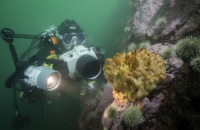
Claire photographs a sponge before she collects a sample. (Photo: Torben Brydges, Fisheries and Oceans Canada.)
What is taxonomy?
Taxonomy is the process of classifying things, especially organisms, within a larger system. It’s about identifying animals or plants and giving them names. Then we place them within the scheme of life based on their similarities and differences. So a marine taxonomist is the best person to go on a beach walk with—we know what everything is!
What is the research museum used for?
All museums store and display things of importance to their subject. Our museum stores preserved fish and invertebrates that have been kept for their scientific value. For example, the bluntnose sixgill shark has only been caught off Atlantic Canadian waters a few times. That’s important to know and be able to confirm, so several of those specimens have been brought to us for safekeeping.
Research museums like the ARC are centres of information for scientists. They use the collections to study and expand the current knowledge of animals and plants. They may investigate questions such as how species ranges are shifting as the climate changes. Scientists can also compare our specimens with theirs to help them identify something, or check if it is a species new to science.
What does your typical day involve?
One of the things I like about my job is that there isn’t really a typical day. I might be in the office writing reports one day and out SCUBA diving the next! When I go diving, I often collect specimens and take them back to the lab to identify them. If it’s an important specimen, we add it to our museum collections. We also like to engage with the community, so I’ll give interviews or answer questions from people that want advice on marine species.
What do you enjoy most about your job?
I enjoy getting to explore and study new areas underwater. It’s a wonderful feeling to be looking out at a community beneath the ocean and know that no one else has ever seen it before. I get to see so many amazing animals, and when I’m SCUBA diving they often approach me! This can be exciting, especially when it’s something large like a basking shark or curious fur seal! My research has taken me all over the world, from Greenland to the Antarctic. I like seeing all the different places and species. It can be challenging, though: sometimes we come across something so weird-looking, we're not even sure what phylum to put it in!
I also find it exciting to classify and identify the different species in each area. When a scientist names a new species, they must deposit a type specimen in a museum as the original example of that species. If I think I have a species new to science, it takes a lot of detective work to prove it! I have to look at the type specimens of closely related species and comb through old literature. But I like the challenge. And it is very satisfying to give something a name that didn’t have one before.
How do you collect specimens?
Usually I collect specimens by SCUBA diving, but I’ve also been on offshore research cruises on big ships. On these, we collected specimens using an ROV (Remotely Operated Vehicle). The ROV allows us to take samples from areas too deep or dangerous to send divers. In Greenland we sampled as deep as 3500 metres—it took over two hours for the ROV to dive down to the seafloor. We sat in the control van watching footage that beamed up to us from the cameras on the ROV. When we spotted an animal we wanted to collect, the ROV pilot grabbed it by using a claw or sucked it up with the slurp gun. It made a nice change to be warm and drinking tea while collecting!
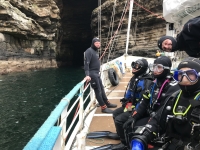
Claire (front) prepares to survey a previously unexplored sea cave in the Falkland Islands. Claire participated as a sponge expert in this South Atlantic Environmental Research Institute expedition. (Photo: Marina Costa/SAERI)
What is an important qualification for your work?
For my role, I need to have a postgraduate degree and a lot of research experience. I did a PhD and worked in a museum in Northern Ireland for several years before moving to the Huntsman Marine Science Centre. I also need advanced diving qualifications. Diving for survey work and collecting specimens can be very challenging. I’ve dived in areas with very strong currents, potentially dangerous marine life such as leopard seals, and even icebergs. You have to be completely comfortable in the water so you can focus on the scientific task at hand. Some of our underwater tasks are very tricky. Imagine trying to put very small animals into very small sample bags while wearing very thick gloves and holding a very large camera. It’s even harder when you’re hovering on a wall and a strong current is trying to suck the specimens away. I learned to dive during my degree and got in the water as much as possible to get experience. I now have well over 1000 dives.
Are there any skills you need to be able to identify species?
To identify a species, you need good observation skills so you can spot the little differences that make it unique. The differences can be tiny, such as one species having more spines on its leg. Since many of our species are very small, we need to use a microscope to see them. It also helps if you know some foreign languages—older species descriptions are often written in French, German, or even Latin.
What inspired you to work in marine biology?
I’ve always enjoyed being outside and observing animals, but I grew up inland so only got to go to the beach on holidays. I was thinking about doing some sort of biology at university but wasn’t sure which kind. When I was 16 I won a competition to go sailing on a tall ship. Despite gale-force winds, I really enjoyed my two weeks on the Irish Sea. After that trip, I chose to study marine biology in the hope of getting more sea time!
Any advice for people wanting to work in this field?
Experience is always a good thing. Get as much experience as you can through internships or volunteer positions. This will help you get a job in what can be a competitive field because you will develop new skills and make contacts with potential employers. It will also help you narrow down the areas you’d most like to work in—there are so many interesting jobs in marine science.
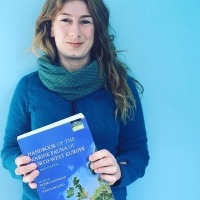
Claire develops resources to help other people identify marine animals. She co-authored the chapter on sponges in this widely used book. (Photo: Huntsman Marine Science Centre)


